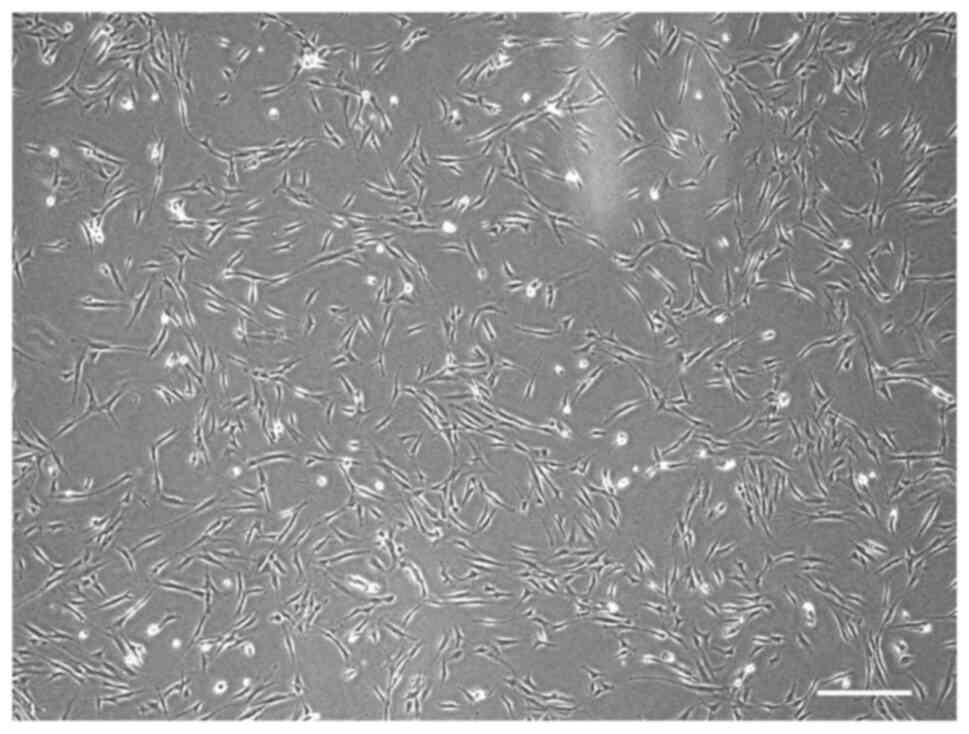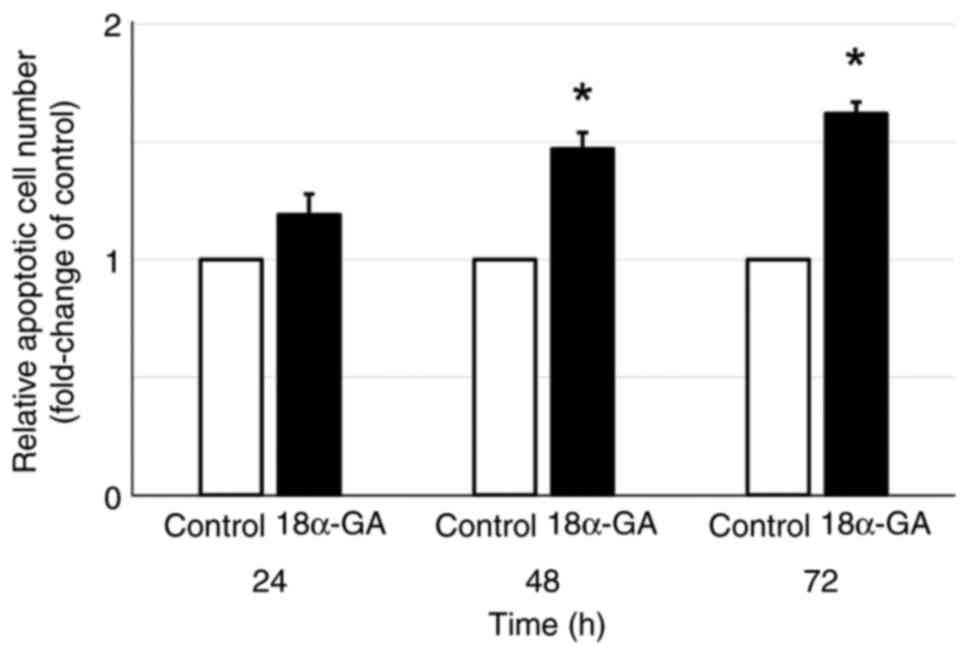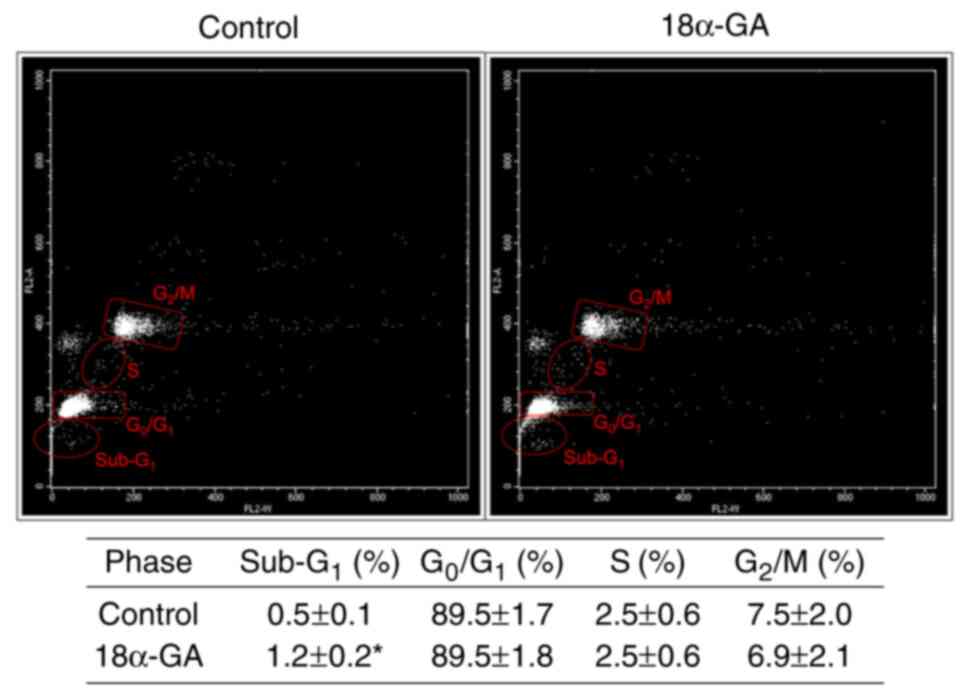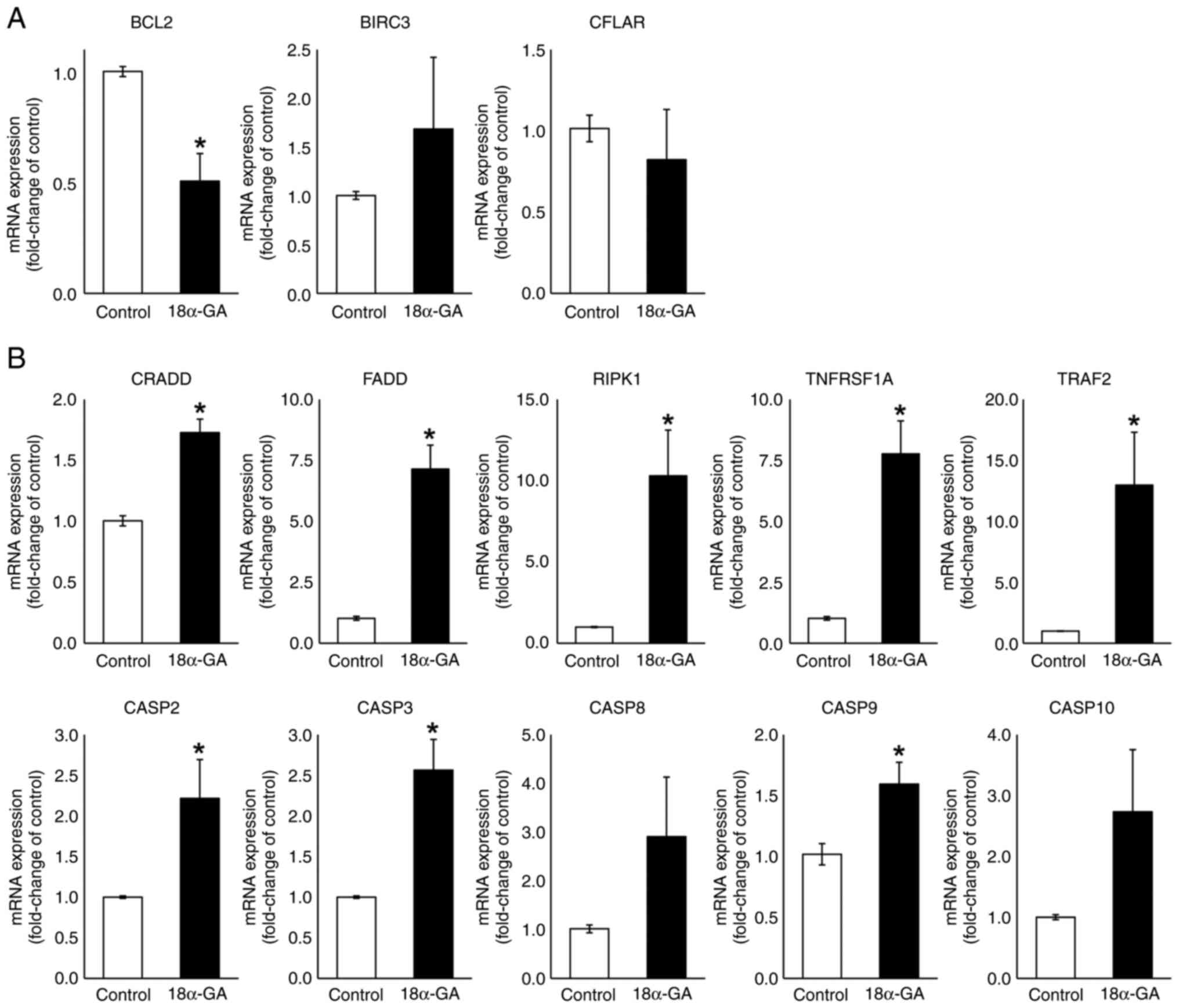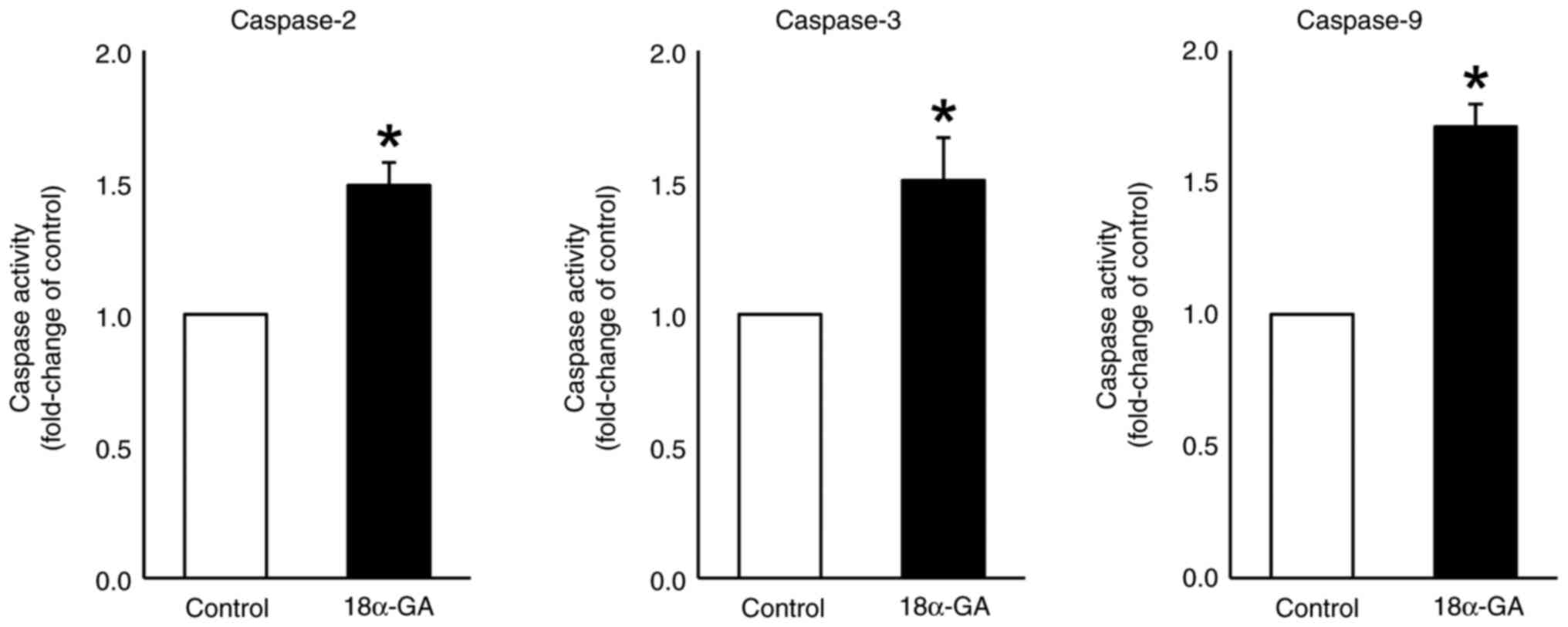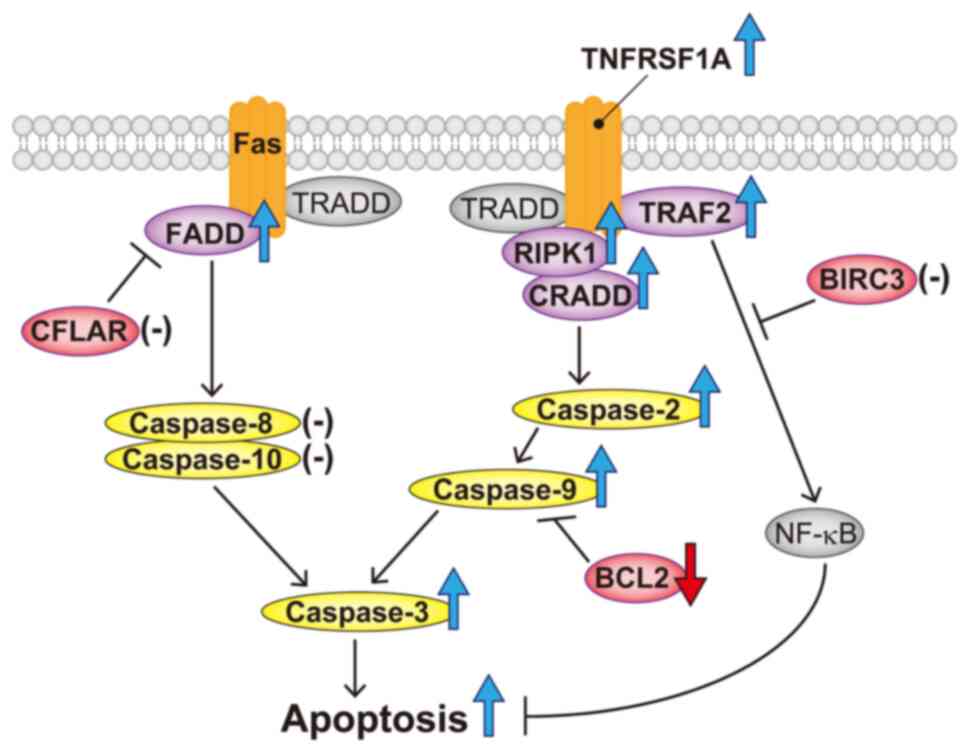18‑α‑glycyrrhetinic acid induces apoptosis in gingival fibroblasts exposed to phenytoin
- Authors:
- Published online on: May 22, 2024 https://doi.org/10.3892/etm.2024.12586
- Article Number: 297
-
Copyright : © Takeuchi et al. This is an open access article distributed under the terms of Creative Commons Attribution License [CC BY 4.0].
Abstract
Introduction
Phenytoin (PHT, an antiepileptic drug), cyclosporin A (an immunosuppressant) and nifedipine (a calcium channel blocker) cause gingival overgrowth as side effects (1-3). Among those drugs, a high probability of gingival overgrowth caused by PHT is known (approximately 50%) (4). A characteristic of gingival overgrowth in clinical conditions is an increase in the size of the gingiva (5). Overgrowth of the gingiva not only disrupts normal mastication but also results in unusual facial features that can cause mental distress (3,6-8). Basic periodontal treatments and surgery are usually performed to improve gingival overgrowth (9), however, an effective medication has not been identified at the present time.
Based on histological observations, PHT-induced gingival overgrowth has characteristic increases in the proliferation of fibroblasts and accumulated amounts of collagen in the gingiva (3,10,11). Gingival fibroblasts are the primary cell type in gingival connective tissue and their role is the maintenance and repair of that tissue (12). The pathogenic mechanisms responsible for PHT-associated gingival overgrowth have been determined using an in vitro model and the effects of PHT on gingival fibroblasts in tissue culture have been investigated (13-17). Fibroblast proliferation is observed in periodontal tissues with PHT-induced gingival overgrowth (18). Furthermore, the interaction of drugs with inflammation causes the increased growth and reduced apoptosis of gingival fibroblasts, and consequently the overgrowth of gingiva proceeds (18,19).
Licorice has long been used as a medicinal herb and as a sweetener to give sweetness to food products (20,21). It contains many phytochemicals including more than 300 flavonoids and 20 triterpenoids (22), and it also inhibits mild inflammation and heals ulcers. In addition, licorice inhibits cell proliferation through blocking the cell cycle in mammalian cells (23), and it also induces apoptosis (24). 18-alpha-Glycyrrhetinic acid (18α-GA) is a bioactive compound extracted from licorice that exhibits many biological and pharmacological effects such as anti-inflammatory effects (25). 18α-GA is also apoptotic promoter in epithelial cell rests of Malassez (24). Also, 18α-GA induces apoptosis in leukemic HL60 cells (26) and in ovarian cancer A2780 cells (27). These findings suggest that 18α-GA could be used to treat PHT-influenced gingival overgrowth since it may induce the apoptosis of gingival fibroblasts.
In this research, we investigated the effects of 18α-GA on apoptosis and on apoptotic regulators in gingival fibroblasts exposed to PHT, to evaluate the therapeutic potential of 18α-GA. The results show that 18α-GA regulates caspase activity in the death receptor pathway in gingival fibroblasts, which results in the induction of apoptosis.
Materials and methods
Cell culture
The methods used in this study are based on previously published reports (3,17,20,28,29). PHT and 18α-GA were purchased from Sigma-Aldrich, Japan K.K. (Tokyo, Japan). Four primary cultures of fibroblasts derived from the gingiva of healthy donors were obtained from ScienCell™ Research Laboratories (cat. no. 2620, https://sciencellonline.com/human-gingival-fibroblasts/, San Diego, CA, USA). Those cells had been cryopreserved at passage one and delivered frozen. Cells were cultured in an atmosphere of 5% CO2/95% air maintained at 37˚C in Dulbecco's modified Eagle medium (High Glucose) with L-Glutamine and Phenol Red (D-MEM, FUJIFILM Wako Pure Chemical Corporation, Osaka, Japan) supplemented with 10% foetal bovine serum, 50 units/ml penicillin and 50 µg/ml streptomycin (Gibco, Thermo Fisher Scientific, Inc., Waltham, MA, USA) until they reached semi-confluence. Cells were routinely passaged using 0.05 w/v% Trypsin-0.53 mmol/l EDTA·4Na Solution with Phenol Red (FUJIFILM Wako Pure Chemical Corporation). Cells were used between passages 6 and 9 for subsequent experiments (Fig. 1). The concentrations of PHT and 18α-GA used in this study were decided according to the results of previous studies as follows: 0.25 µM PHT significantly inhibited the G1 cell cycle arrest and increased the cell proliferation of gingival fibroblasts compared with the untreated control (17,29); 10 µM 18α-GA significantly decreased the proliferation of gingival fibroblasts compared with 0, 0.1, and 1 µM 18α-GA (20).
Apoptosis assay
Apoptosis assays were performed using an APOPercentage™ Apoptosis Assay Kit (BiocolourLtd., Northern Ireland, UK). After semiconfluent cells were treated with 0.25 µM PHT with or without 10 µM 18α-GA in serum-free D-MEM for 24, 48 and 72 h, the apoptotic cells were labelled with APOPercentage Dye in fresh D-MEM at 37˚C in 5% CO2 for 1 h. The D-MEM containing the dye was removed, after which the APOPercentage Dye release reagent was added into the cell culture plates and the plates were gently shaken for 10 min. The absorbance of the released dye at 550 nm was then determined. The methods used in this study are based on previously published reports (3,17,20).
Propidium iodide staining and flow cytometric analysis
The propidium iodide staining and flow cytometric analysis were performed using a CycleTEST™ plus DNA Reagent Kit (Becton Dickinson and Company, Franklin Lakes, NJ, USA; BD). After semiconfluent cells were treated with 0.25 µM PHT with or without 10 µM 18α-GA in serum-free D-MEM for 48 h, cells were harvested by trypsinization, washed three times with Buffer Solution, and then treated with Solution A (trypsin buffer), Solution B (trypsin inhibitor and RNase buffer) and Solution C (PI stain solution) in accordance with the manufacturer's instructions. A BD FACSCalibur™ Flow Cytometer (BD Biosciences) acquired 20,000 events for each sample, and the percentage of cells in the Sub-G1 (apoptotic), G0/G1, S and G2/M phases of the cell cycle were determined using BD CellQuest Pro Software (version 3.1, BD Biosciences). The methods used in this study are based on previously published reports (3,17,20).
RNA isolation and reverse transcription-quantitative PCR (RT-qPCR)
After semiconfluent cells were treated with 0.25 µM PHT with or without 10 µM 18α-GA in serum-free D-MEM for 12 h, total RNA was immediately extracted from the cells using a RNeasy Mini Kit (QIAGEN, Tokyo, Japan). A standard spectrophotometric method was used to assess the concentration and purity of each extracted total RNA. One µg of each total RNA was then reverse-transcribed using a PrimeScript™ RT reagent Kit (TAKARA BIO INC., Shiga, Japan). The cDNAs were analyzed by qPCR in an Eco™ Real-Time PCR System (Illumina, Inc., San Diego, CA, USA) using a KAPA SYBR® FAST qPCR Master Mix Kit (KAPA BIOSYSTEMS Inc., Wilmington, MA, USA). The following thermocycling conditions were used for qPCR: Enzyme activation at 95˚C for 30 sec, followed by 45 cycles of denaturation at 95˚C for 5 sec and annealing and extension at 60˚C for 20 sec. A Perfect Real Time Support System (TAKARA BIO INC.) was used to synthesize the following PCR primers: B-cell CLL/lymphoma 2 (BCL2); baculoviral IAP repeat containing 3 (BIRC3); CASP8 and FADD-like apoptosis regulator (CFLAR); CASP2 and RIPK1 domain containing adaptor with death domain (CRADD); Fas (TNFRSF6)-associated via death domain (FADD); receptor (TNFRSF)-interacting serine-threonine kinase 1 (RIPK1); tumor necrosis factor receptor superfamily; member 1A (TNFRSF1A); TNF receptor-associated factor 2 (TRAF2); and glyceraldehyde-3-phosphate dehydrogenase (GAPDH). These primer sequences were used according to the method of Takeuchi et al (3). The PCR primers for Caspases-2, -3, -8, -9 and -10 were synthesized by Custom DNA Oligos (Merck KGaA, Darmstadt, Germany) and Primer-BLAST (National Library of Medicine, Bethesda, MD, USA). Primer sequences used are listed in Table I. Relative quantification was calculated using the 2-∆∆Cq method (30). After normalization to GAPDH, RNA ratios in treated vs. control cultures were determined. The methods used in this study are based on previously published reports (3).
Western blot analysis
After semiconfluent cells were treated with 0.25 µM PHT with or without 10 µM 18α-GA in serum-free D-MEM for 24 h, the cells were washed with 37˚C PBS and lysed using β-ME Sample Treatment for Tris SDS (COSMO BIO Co., LTD, Tokyo, Japan). Protein concentrations were determined using a TaKaRa Bradford Protein Assay Kit (TAKARA BIO INC.). Equal quantities of protein extracts (10 µg/lane) were separated via SDS-PAGE with Running Buffer Solution for SDS-PAGE (NACALAI TESQUE, INC., Kyoto, Japan) after which the proteins were transferred to PVDF membranes. The membranes were blocked for 30 min at room temperature with Bullet Blocking One for Western Blotting (NACALAI TESQUE), after which they were probed at room temperature for 1 h with primary antibodies against Caspase-2 (1:500), Caspase-3 (1:1,000), Caspase-9 (1:1,000) and β-Actin (1:1,000). The membranes were washed three times with Tris Buffered Saline with 0.05%-Detergent (NACALAI TESQUE) for 5 min at room temperature, and were then incubated with the secondary antibody (1:10,000) at room temperature for 45 min. The primary and secondary antibodies were diluted using Can Get Signal® Immunoreaction Enhancer Solution (TOYOBO CO., LTD., Osaka, Japan). After washing, the blots were detected using Chemi-Lumi One Super (NACALAI TESQUE) and ChemiDoc™ MP Imaging System (Bio-Rad Laboratories, Inc., Hercules, CA, USA). The densities of western blot bands were measured using ImageJ (1.53t; Java 1.8.0_345 [64-bit]). Primary antibodies against Caspase-3 (cat. no. #9662), Caspase-9 (cat. no. #9502) and β-Actin (cat. no. #4967), as well as anti-rabbit HRP-conjugated IgG were purchased from Cell Signaling Technology, Inc. (Danvers, MA, USA). Rabbit monoclonal anti-Caspase-2 antibody (cat. no. ab32021) was purchased from Abcam plc. (Cambridge, UK). The secondary antibody (anti-rabbit IgG, HRP-linked antibody; cat. no. #7074) was purchased from Cell Signaling Technology. The methods used in this study are based on previously published reports (3).
Detection of caspase activity
After semiconfluent cells were treated with 0.25 µM PHT with or without 10 µM 18α-GA in serum-free D-MEM for 24 h, Caspase-2, -3 and -9 Colorimetric Assay Kits (Medical & Biological Laboratories Co., Ltd., Nagoya, Japan) and a spectrophotometer at 405 nm were used according to the manufacturer's protocols to assess caspase activities. Caspase-2, caspase-3 and caspase-9 were labelled using the synthetic peptide substrates VDVAD-p-nitroanilide (pNA), DEVD-pNA and LEHD-pNA respectively. The methods used in this study are based on previously published reports (3,20,28).
Statistical analysis
All data are reported as mean ± standard error of the mean (SEM). Statistical analysis was carried out using Welch's t-test. P values <0.05 were considered to indicate a statistically significant difference.
Results
Relative number of apoptotic cells after treatment of gingival fibroblasts with 18α-GA
Apoptosis was assessed in gingival fibroblasts after treatment with or without 18α-GA. As shown in Fig. 2, gingival fibroblasts treated with 18α-GA showed a time-dependent increase in the relative number of apoptotic cells compared to the untreated control with significant increases at 48 h (1.5-fold) and at 72 h (1.6-fold).
Apoptotic population and cell cycle dynamics of gingival fibroblasts treated with 18α-GA
We analyzed the apoptotic cell population (sub-G1) and the distribution of cell cycle phases (G0/G1, S, and G2/M) in gingival fibroblasts treated with or without 18α-GA. As shown in Fig. 3, treatment with 18α-GA significantly increased the number of apoptotic cells, however it did not change the distribution of cells in the G0/G1, S and G2/M phase.
mRNA expression levels in gingival fibroblasts treated with 18α-GA
We analyzed the effects of 18α-GA treatment of gingival fibroblasts on their mRNA expression levels of apoptotic factors (BCL2, BIRC3, CFLAR, CRADD, FADD, RIPK1, TNFRSF1A, TRAF2, CASP2, CASP3, CASP8, CASP9 and CASP10) using qPCR. As shown in Fig. 4, the treatment of gingival fibroblasts with 18α-GA significantly reduced the BCL2 (0.5-fold) mRNA expression level and significantly increased CRADD (1.7-fold), FADD (7.1-fold), RIPK1 (10.3-fold), TNFRSF1A (7.8-fold) and TRAF2 (13.0-fold) mRNA expression levels. Treatment with 18α-GA also increased the BIRC3 (1.7-fold) mRNA expression level and decreased the CFLAR (0.8-fold) mRNA expression level but not significantly. Treatment of gingival fibroblasts with 18α-GA also significantly increased CASP2 (2.2-fold), CASP3 (2.6-fold) and CASP9 (1.6-fold) mRNA expression levels and increased CASP8 (2.9-fold) and CASP10 (2.7-fold) mRNA expression levels but not significantly.
Protein expression in gingival fibroblasts treated with 18α-GA
We analyzed the effects of 18α-GA treatment of gingival fibroblasts on the protein expression of caspases- 2, 3 and 9 using western blot analysis. As shown in Fig. 5, treatment of gingival fibroblasts with 18α-GA significantly increased the protein expression levels of caspase-2 (2.3-fold), caspase-3 (2.7-fold) and caspase-9 (2.8-fold) compared to the levels observed in control cells.
Caspase activity in gingival fibroblasts treated with 18α-GA
We assessed the effects of treating gingival fibroblasts with 18α-GA on the activities of caspases- 2, 3 and 9. As shown in Fig. 6, treatment with 18α-GA significantly up-regulated the activities of caspase-2 (1.5-fold), caspase-3 (1.5-fold) and caspase-9 (1.7-fold) compared to the levels observed in control cells.
Discussion
In the present study, we determined whether treatment with 18α-GA affects apoptosis of gingival fibroblasts exposed to PHT. The purpose of this study was to establish a basis for the therapeutic application of 18α-GA to treat PHT-induced gingival overgrowth. We found that 18α-GA induced the apoptosis of gingival fibroblasts by activating the caspase cascade in the death receptor pathway.
Gingival overgrowth is caused by the increased proliferation and the decreased apoptosis of gingival fibroblasts that are exposed to drugs, such as PHT (3). The pathogenesis of this disease is also associated with the gingiva including inflammation (31). 18α-GA promotes the apoptosis of multiple types of cells, including porcine epithelial cell rests of Malassez cells (24), leukemic HL60 cells (26), ovarian cancer A2780 cells (27) and murine microglial BV2 cells (32). In this study, we found that 18α-GA induced the apoptosis of gingival fibroblasts. Conversely, transformed cells with severe DNA damage are cleared by cellular apoptosis (33). Several studies have proposed that the pathogenesis of gingival overgrowth involves the inhibition of apoptosis (3,34,35). We have also demonstrated that gingival overgrowth is attributed to reduced apoptosis in gingival fibroblasts derived from patients with gingival overgrowth (28).
Apoptosis is programmed cell death characterized by an elaborate sequence of morphological events including nuclear condensation (pyknosis) and fragmentation (karyorrhexis), along with blebbing of the plasma membrane, both of which contribute to the formation of apoptotic bodies (36,37). The two main pathways of apoptotic cell death are the intrinsic and extrinsic pathways. The intrinsic pathway is marked by mitochondrial outer membrane permeabilization, which releases cytochrome c from the mitochondrial intermembrane space (38). The extrinsic pathway is activated in response to specific death receptors which are Fas, TNF receptor 1 (TNFR1) or TNF-related apoptosis-inducing ligand receptor. Both pathways trigger downstream effector caspases such as caspase-3 that lead to apoptotic cell death (36,39). The expression of caspase-3 protein is attenuated in tissues of gingiva derived from patients treated with cyclosporin A and/or nifedipine, and from those with PHT-induced gingival overgrowth (3,18,35). PHT treatment of gingival fibroblasts from healthy donors also reduced the expression and activity of caspase-3(3). In this study, we show that treatment with 18α-GA enhances the mRNA and protein expression levels of caspase-3 and increases the activation of caspase-3.
To elucidate the pro-apoptotic mechanism of 18α-GA in the death receptor pathway of gingival fibroblasts exposed to PHT, we examined the mRNA expression levels of apoptotic genes, including inducers (CRADD, FADD, RIPK1, TNFRSF1A and TRAF2), an effector (CASP3), initiators (CASP2, CASP8, CASP9 and CASP10), inhibitors (BCL2, BIRC3 and CFLAR) and the protein expression levels and activities of caspases (2, 3 and 9) in those cells. We found that treatment with 18α-GA reduced the mRNA expression level of BCL2, enhanced the mRNA expression levels of CASP2, CASP3, CASP9, CRADD, FADD, RIPK1, TNFRSF1A and TRAF2, and increased the protein expression levels and activities of caspase-2, caspase-3 and caspase-9 in gingival fibroblasts treated with PHT.
As mentioned above, the major death receptors are Fas and TNFR1. After those receptors are activated by extracellular ligands such as Fas ligand (Fas-L) and TNF ligands, initiator caspases (2, 8, 9 and 10) activate executioner caspases (3, 6 and 7) in cooperation with various apoptotic mediators, and consequently, apoptosis is induced (40). When Fas is bound by its ligand Fas-L, the resulting conformational change in Fas DD (Fas death domain) allows it to bind to FADD DD. The binding of Fas DD to FADD DD causes the exposed DED (death effector domain) on FADD (40). The binding of TNF-α (one of the TNF ligands) to TNF receptor-1, which is encoded by TNFRSF1A, results in the recruitment of the adapter proteins FADD and TRADD (3,41-43). FADD then activates caspase-8 and caspase-10. Caspase-8 can cleave and activate the apoptosis executioner caspase-3(40). The action of c-FLIP, which is encoded by CFLAR, prevents FADD recruitment (44,45). On the other hand, when the adapter protein TRAF2 binds to the TNF receptor-1/TRADD complex, NF-κB is activated and apoptosis is inhibited (46). c-IAP2, which is encoded by BIRC3, inhibits the activation of NF-κB (47,48). A complex consisting of CRADD-activated caspase-2, RIPK1 and TNF receptor-1 activates caspase-9 and caspase-3, which can induce apoptosis (49). BCL2 prevents apoptosis by depressing the activation of caspase-9(50).
Our results show that 18α-GA has the following effects on gingival fibroblasts exposed to PHT: a decrease in the BCL2 mRNA expression level; increases in CRADD, FADD, RIPK1, TNFRSF1A and TRAF2 mRNA expression levels; increases in CASP2, CASP3 and CASP9 mRNA expression levels and increases in caspase-2, caspase-3 and caspase-9 protein expression levels and activities. Based on the above results, the apoptotic mechanism of 18α-GA in gingival fibroblasts treated with PHT may be as follows: 18α-GA modulates the TNF pathway by upregulating TNFRSF1A, TRAF2, RIPK1 and CRADD, which induce apoptosis via the activation of caspase-2, caspase-9 and caspase-3; 18α-GA affects the Fas pathway by upregulating FADD and induces apoptosis by downregulating BCL2 (shown schematically in Fig. 7). The release of cytochrome c to the cytoplasm from mitochondria also activates caspase-9(3). Thus, 18α-GA may affect apoptosis via the mitochondrial pathway in gingival fibroblasts.
This study demonstrates that 18α-GA induces apoptosis through activating the pathways of Fas and TNF in the death receptor signaling pathway of gingival fibroblasts treated with PHT. In conclusion, 18α-GA has a therapeutic potential for the treatment of PHT-induced gingival overgrowth. Future studies should investigate the alterations of the mitochondrial pathway in gingival fibroblasts caused by 18α-GA treatment. The mechanism of gingival overgrowth induced by PHT is related to the accumulation of collagen by its enhanced production in numerous gingival fibroblasts (3) or by the impaired metabolism caused by TNF-α and PHT together (7). The fact that TNF-α activates NF-κB may also be related to the accumulation of collagen in the gingiva (3). Thus, future studies should aim to clarify whether 18α-GA affects collagen production/metabolism in gingival fibroblasts exposed to PHT.
Acknowledgements
Not applicable.
Funding
Funding: The present study was supported by JSPS KAKENHI (grant no. 23K09514).
Availability of data and materials
The datasets used and/or analyzed during the current study are available from the corresponding author on reasonable request.
Author's contributions
RT, TNomo and KH designed the study. RT, TNomu, MY, CT, IS, HM and YO carried out the experiments. RT, TNomu and MY performed the apoptosis assay and the flow cytometric analysis. RT, CT and IS performed the reverse transcription-quantitative PCR. RT, TNomu and YO performed the western blot analysis. RT and HM detected the caspase activity. RT, HS and KA analyzed the data. RT and MY confirmed the authenticity of all raw data. RT drafted the original manuscript. All authors reviewed the manuscript draft and revised it critically for intellectual content. All authors have read and approved the final manuscript.
Ethics approval and consent to participate
For the use of primary human cell lines, ScienCell Research Laboratories strictly comply with the policies provided on website: https://sciencellonline.com/technical-support/ethical-statement.html. This study was approved by the Ethics Review Committee of Nihon University School of Dentistry at Matsudo (approval no. EC23-18).
Patient consent for publication
Not applicable.
Competing interests
The authors declare that they have no competing interests.
References
|
Takeuchi R: The effect of basic fibroblast growth factor on cell cycle in human gingival fibroblasts from nifedipine responder and non-responder. J Oral Sci. 46:37–44. 2004.PubMed/NCBI View Article : Google Scholar | |
|
Takeuchi R, Matsumoto H, Okada H, Hori M, Gunji A, Hakozaki K, Akimoto Y and Fujii A: Differences of cell growth and cell cycle regulators induced by basic fibroblast growth factor between nifedipine responders and non-responders. J Pharmacol Sci. 103:168–174. 2007.PubMed/NCBI View Article : Google Scholar | |
|
Takeuchi R, Matsumoto H, Arikawa K, Taguchi C, Nakayama R, Nasu I and Hiratsuka K: Phenytoin-induced gingival overgrowth caused by death receptor pathway malfunction. Oral Dis. 23:653–659. 2017.PubMed/NCBI View Article : Google Scholar | |
|
Nakib N and Ashrafi SS: Drug-induced gingival overgrowth. Dis Mon. 57:225–230. 2011.PubMed/NCBI View Article : Google Scholar | |
|
Corrêa JD, Queiroz-Junior CM, Costa JE, Teixeira AL and Silva TA: Phenytoin-induced gingival overgrowth: A review of the molecular, immune, and inflammatory features. ISRN Dent. 2011(497850)2011.PubMed/NCBI View Article : Google Scholar | |
|
Hassell TM and Hefti AF: Drug-induced gingival overgrowth: Old problem, new problem. Crit Rev Oral Biol Med. 2:103–137. 1991.PubMed/NCBI View Article : Google Scholar | |
|
Kato T, Okahashi N, Ohno T, Inaba H, Kawai S and Amano A: Effect of phenytoin on collagen accumulation by human gingival fibroblasts exposed to TNF-alpha in vitro. Oral Dis. 12:156–162. 2006.PubMed/NCBI View Article : Google Scholar | |
|
Bajkovec L, Mrzljak A, Likic R and Alajbeg I: Drug-induced gingival overgrowth in cardiovascular patients. World J Cardiol. 13:68–75. 2021.PubMed/NCBI View Article : Google Scholar | |
|
Morikawa S, Nasu M, Miyashita Y and Nakagawa T: Treatment of calcium channel blocker-induced gingival overgrowth without modifying medication. BMJ Case Rep. 14(e238872)2021.PubMed/NCBI View Article : Google Scholar | |
|
Hallmon WW and Rossmann JA: The role of drugs in the pathogenesis of gingival overgrowth. A collective review of current concepts. Periodontol 2000. 21:176–196. 1999.PubMed/NCBI View Article : Google Scholar | |
|
Naruishi K: Biological roles of fibroblasts in periodontal diseases. Cells. 11(3345)2022.PubMed/NCBI View Article : Google Scholar | |
|
Alikhani M, Alikhani Z and Graves DT: Apoptotic effects of LPS on fibroblasts are indirectly mediated through TNFR1. J Dent Res. 83:671–676. 2004.PubMed/NCBI View Article : Google Scholar | |
|
Shafer WG: Effect of dilantin sodium analogues on cell proliferation in tissue culture. Proc Soc Exp Biol Med. 106:205–207. 1961.PubMed/NCBI View Article : Google Scholar | |
|
Smith QT and Hinrichs JE: Phenytoin and 5-(p-hydroxyphenyl)-5-phenylhydantoin do not alter the effects of bacterial and amplified plaque extracts on cultures of fibroblasts from normal and overgrown gingivae. J Dent Res. 66:1393–1398. 1987.PubMed/NCBI View Article : Google Scholar | |
|
Vernillo AT and Schwartz NB: The effects of phenytoin (5,5-diphenylhydantoin) on human gingival fibroblasts in culture. J Periodontal Res. 22:307–312. 1987.PubMed/NCBI View Article : Google Scholar | |
|
Vijayasingham SM, Dykes PJ and Marks R: Phenytoin has little effect on in-vitro models of wound healing. Br J Dermatol. 125:136–139. 1991.PubMed/NCBI View Article : Google Scholar | |
|
Takeuchi R, Matsumoto H, Akimoto Y and Fujii A: Inhibition of G1 cell cycle arrest in human gingival fibroblasts exposed to phenytoin. Fundam Clin Pharmacol. 28:114–119. 2014.PubMed/NCBI View Article : Google Scholar | |
|
Kantarci A, Augustin P, Firatli E, Sheff MC, Hasturk H, Graves DT and Trackman PC: Apoptosis in gingival overgrowth tissues. J Dent Res. 86:888–892. 2007.PubMed/NCBI View Article : Google Scholar | |
|
Jung JY, Jeong YJ, Jeong TS, Chung HJ and Kim WJ: Inhibition of apoptotic signals in overgrowth of human gingival fibroblasts by cyclosporin A treatment. Arch Oral Biol. 53:1042–1049. 2008.PubMed/NCBI View Article : Google Scholar | |
|
Takeuchi R, Hiratsuka K, Arikawa K, Ono M, Komiya M, Akimoto Y, Fujii A and Matsumoto H: Possible pharmacotherapy for nifedipine-induced gingival overgrowth: 18a-glycyrrhetinic acid inhibits human gingival fibroblast growth. Br J Pharmacol. 173:913–924. 2016.PubMed/NCBI View Article : Google Scholar | |
|
Ding Y, Brand E, Wang W and Zhao Z: Licorice: Resources, applications in ancient and modern times. J Ethnopharmacol. 298(115594)2022.PubMed/NCBI View Article : Google Scholar | |
|
Moustafa GO, Shalaby A, Naglah AM, Mounier MM, El-Sayed H, Anwar MM and Nossier ES: Synthesis, characterization, in vitro anticancer potentiality, and antimicrobial activities of novel peptide-glycyrrhetinic-acid-based derivatives. Molecules. 26(4573)2021.PubMed/NCBI View Article : Google Scholar | |
|
Chu XT, de la Cruz J, Hwang SG and Hong H: Tumorigenic effects of endocrine-disrupting chemicals are alleviated by licorice (Glycyrrhiza glabra) root extract through suppression of AhR expression in mammalian cells. Asian Pac J Cancer Prev. 15:4809–4813. 2014.PubMed/NCBI View Article : Google Scholar | |
|
Haku K, Muramatsu T, Hara A, Kikuchi A, Hashimoto S, Inoue T and Shimono M: Epithelial cell rests of Malassez modulate cell proliferation, differentiation and apoptosis via gap junctional communication under mechanical stretching in vitro. Bull Tokyo Dent Coll. 52:173–182. 2011.PubMed/NCBI View Article : Google Scholar | |
|
Tiboni M, Benedetti S, Skouras A, Curzi G, Perinelli DR, Palmieri GF and Casettari L: 3D-printed microfluidic chip for the preparation of glycyrrhetinic acid-loaded ethanolic liposomes. Int J Pharm. 584(119436)2020.PubMed/NCBI View Article : Google Scholar | |
|
Pirzadeh S, Fakhari S, Jalili A, Mirzai S, Ghaderi B and Haghshenas V: Glycyrrhetinic acid induces apoptosis in Leukemic HL60 cells through upregulating of CD95/CD178. Int J Mol Cell Med. 3:272–278. 2014.PubMed/NCBI | |
|
Haghshenas V, Fakhari S, Mirzaie S, Rahmani M, Farhadifar F, Pirzadeh S and Jalili A: Glycyrrhetinic acid inhibits cell growth and induces apoptosis in ovarian cancer a2780 cells. Adv Pharm Bull. 4 (Suppl 1):S437–S441. 2014.PubMed/NCBI View Article : Google Scholar | |
|
Takeuchi R, Matsumoto H, Akimoto Y and Fujii A: Reduction in lipopolysaccharide-induced apoptosis of fibroblasts obtained from a patient with gingival overgrowth during nifedipine-treatment. Arch Oral Biol. 56:1073–1080. 2011.PubMed/NCBI View Article : Google Scholar | |
|
Sano M, Ohuchi N, Inoue T, Tono K, Tachikawa T, Kizawa Y and Murakami H: Proliferative response to phenytoin and nifedipine in gingival fibroblasts cultured from humans with gingival fibromatosis. Fundam Clin Pharmacol. 18:465–470. 2004.PubMed/NCBI View Article : Google Scholar | |
|
Livak KJ and Schmittgen TD: Analysis of relative gene expression data using real-time quantitative PCR and the 2(-Delta Delta C(T)) method. Methods. 25:402–408. 2001.PubMed/NCBI View Article : Google Scholar | |
|
Mitic K, Popovska M, Pandilova M, Jovanovic R, Spasovski G and Nikolov V: The role of inflammation and apoptosis in cyclosporine A-induced gingival overgrowth. Bosn J Basic Med Sci. 13:14–20. 2013.PubMed/NCBI View Article : Google Scholar | |
|
Ma Y, Cao W, Wang L, Jiang J, Nie H, Wang B, Wei X and Ying W: Basal CD38/cyclic ADP-ribose-dependent signaling mediates ATP release and survival of microglia by modulating connexin 43 hemichannels. Glia. 62:943–955. 2014.PubMed/NCBI View Article : Google Scholar | |
|
Gottlieb TM and Oren M: p53 in growth control and neoplasia. Biochim Biophys Acta. 1287:77–102. 1996.PubMed/NCBI View Article : Google Scholar | |
|
Bulut S, Ozdemir BH, Alaaddinoĝlu EE, Oduncuoĝlu FB, Bulut OE and Demirhan B: Effect of cyclosporin A on apoptosis and expression of p53 and bcl-2 proteins in the gingiva of renal transplant patients. J Periodontol. 76:691–695. 2005.PubMed/NCBI View Article : Google Scholar | |
|
Bulut S and Ozdemir BH: Apoptosis and expression of caspase-3 in cyclosporin-induced gingival overgrowth. J Periodontol. 78:2364–2368. 2007.PubMed/NCBI View Article : Google Scholar | |
|
Das S, Shukla N, Singh SS, Kushwaha S and Shrivastava R: Mechanism of interaction between autophagy and apoptosis in cancer. Apoptosis. 26:512–533. 2021.PubMed/NCBI View Article : Google Scholar | |
|
Feng S, Zha Z, Wang Z, Yang P, Wu J, Li X, Xu Q and Liu Y: Anticancer activity of oleiferoside B involving autophagy and apoptosis through increasing ROS release in MCF-7 cells and SMMC-7721 cells. Nat Prod Res. 35:4865–4869. 2021.PubMed/NCBI View Article : Google Scholar | |
|
Peña-Blanco A and García-Sáez AJ: Bax, Bak and beyond-mitochondrial performance in apoptosis. FEBS J. 285:416–431. 2018.PubMed/NCBI View Article : Google Scholar | |
|
Füllsack S, Rosenthal A, Wajant H and Siegmund D: Redundant and receptor-specific activities of TRADD, RIPK1 and FADD in death receptor signaling. Cell Death Dis. 10(122)2019.PubMed/NCBI View Article : Google Scholar | |
|
Green DR: The death receptor pathway of apoptosis. Cold Spring Harb Perspect Biol. 14(a041053)2022.PubMed/NCBI View Article : Google Scholar | |
|
Hsu H, Xiong J and Goeddel DV: The TNF receptor 1-associated protein TRADD signals cell death and NF-kappa B activation. Cell. 81:495–504. 1995.PubMed/NCBI View Article : Google Scholar | |
|
Grimm S, Stanger BZ and Leder P: RIP and FADD: Two ‘death domain’-containing proteins can induce apoptosis by convergent, but dissociable, pathways. Proc Natl Acad Sci USA. 93:10923–10927. 1996.PubMed/NCBI View Article : Google Scholar | |
|
Wajant H: The Fas signaling pathway: More than a paradigm. Science. 296:1635–1636. 2002.PubMed/NCBI View Article : Google Scholar | |
|
Nikoletopoulou V, Markaki M, Palikaras K and Tavernarakis N: Crosstalk between apoptosis, necrosis and autophagy. Biochim Biophys Acta. 1833:3448–3459. 2013.PubMed/NCBI View Article : Google Scholar | |
|
Irmler M, Thome M, Hahne M, Schneider P, Hofmann K, Steiner V, Bodmer JL, Schröter M, Burns K, Mattmann C, et al: Inhibition of death receptor signals by cellular FLIP. Nature. 388:190–195. 1997.PubMed/NCBI View Article : Google Scholar | |
|
Palladino MA, Bahjat FR, Theodorakis EA and Moldawer LL: Anti-TNF-alpha therapies: The next generation. Nat Rev Drug Discov. 2:736–46. 2003.PubMed/NCBI View Article : Google Scholar | |
|
Maas C, Tromp JM, van Laar J, Thijssen R, Elias JA, Malara A, Krippner-Heidenreich A, Silke J, van Oers MH and Eldering E: CLL cells are resistant to smac mimetics because of an inability to form a ripoptosome complex. Cell Death Dis. 4(e782)2013.PubMed/NCBI View Article : Google Scholar | |
|
Gray CM, McCorkell KA, Chunduru SK, McKinlay MA and May MJ: Negative feedback regulation of NF-κB-inducing kinase is proteasome-dependent but does not require cellular inhibitors of apoptosis. Biochem Biophys Res Commun. 450:341–346. 2014.PubMed/NCBI View Article : Google Scholar | |
|
Krumschnabel G, Sohm B, Bock F, Manzl C and Villunger A: The enigma of caspase-2: The laymen's view. Cell Death Differ. 16:195–207. 2009.PubMed/NCBI View Article : Google Scholar | |
|
Werner AB, de Vries E, Tait SW, Bontjer I and Borst J: Bcl-2 family member Bfl-1/A1 sequesters truncated bid to inhibit its collaboration with pro-apoptotic Bak or Bax. J Biol Chem. 277:22781–22788. 2002.PubMed/NCBI View Article : Google Scholar |



